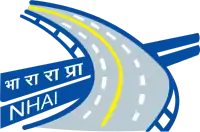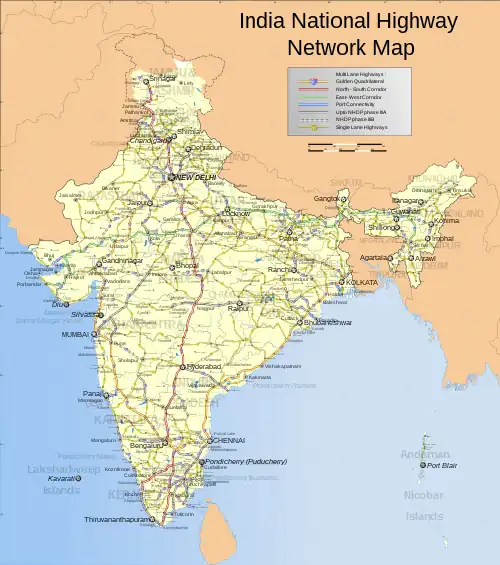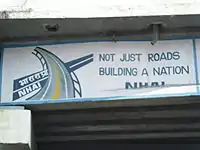भारतीय राष्ट्रीय राजमार्ग प्राधिकरण | |
 NHAI Logo | |
 India National Highways Map | |
| Abbreviation | NHAI |
|---|---|
| Formation | 1995 (Act 1988)[1] |
| Type | Government Agency |
| Legal status | Active |
| Purpose | Development and maintenance of National Highways and Expressways. |
| Headquarters | Sector-10, Dwarka, Delhi |
Region served | |
Official language | English and Hindi |
Chairman | Santosh Kumar Yadav (IAS) |
Member (Finance) | NRVVMK Rajendra Kumar |
Member (Projects) | V. K. Rajawat |
Member (Technical) | Alok Deepankar |
Main organ | Board of directors[2] |
Parent organisation | Ministry of Road Transport and Highways, Government of India |
Budget | ₹162,207 crore (US$20 billion) (2023-24 est.) |
| Website | nhai.gov.in |
.jpg.webp)

The National Highways Authority of India or NHAI (Hindi: भारतीय राष्ट्रीय राजमार्ग प्राधिकरण, romanized: Bhāratīya Rāṣṭrīya Rājmārg Prādhikaraṇ) is an autonomous agency of the Government of India, set up in 1995 (Act 1988) and is responsible for management of a road network of over 50,000 km of National Highways out of 1,32,499 km in India.[4] It is a nodal agency of the Ministry of Road Transport and Highways (MoRTH). NHAI has signed a memorandum of understanding (MoU) with the Indian Space Research Organisation (ISRO) for satellite mapping of highways.[5]
History
The NHAI was created through the promulgation of the National Highways Authority of India Act, 1988. Section 16(1) of the Act states that the function of NHAI is to develop, maintain and manage the national highways and any other highways vested in, or entrusted to, it by the Government of India. On 10 February 1995, NHAI came into operations and was formally made an autonomous body.[1] It is responsible for the development, maintenance and management of National Highways, totaling over 92,851.05 km (57,694.97 mi) in length.[6] The NHAI is also responsible of the toll collection on several highways.[7] Yogendra Narain was the first Chairman of NHAI in 1988. He is a retired IAS officer of Uttar Pradesh cadre. In June 2022, the NHAI created a Guinness World record by building 75 km of highway between Amravati and Akola in Maharashtra in a span of just 5 days.[8]
Projects

The NHAI has the mandate to implement the National Highways Development Project (NHDP). The NHDP is under implementation in Phases.[6]
- Phase I: Approved in December 2000, at an estimated cost of ₹300 billion, it included the Golden Quadrilateral (GQ), portions of the NS-EW Corridors, and connectivity of major ports to National Highways.
- Phase II: Approved in December 2003, at an estimated cost of ₹343 billion, it included the completion of the NS-EW corridors and another 486 km (302 mi) of highways.
- Phase IIIA: This phase was approved in March 2005, at an estimated cost of ₹222 billion, it includes an upgrade to 4-lanes of 4,035 km (2,507 mi)of National Highways.
- Phase IIIB: This was approved in April 2006, at an estimated cost of ₹543 billion, it includes an upgrade to 4-lanes of 8,074 km (5,017 mi) of National Highways.
- Phase V: Approved in October 2006, it includes upgrades to 6-lanes for 6,500 km (4,000 mi), of which 5,700 km (3,500 mi) is on the GQ. This phase is entirely on a DBFO basis.
- Phase VI: This phase, approved in November 2006, will develop 1,000 km (620 mi) of expressways at an estimated cost of ₹ 167 billion.
- Phase VII: This phase, approved in December 2007 will develop ring-roads, bypasses and flyovers to avoid traffic bottlenecks on selected stretches at a cost of ₹167 billion.
NHAI along with NHIDCL helps in implementing Special Accelerated Road Development Programme for North Eastern Region (SARDP-NE); a project to upgrade National Highways connecting state capitals to 2 lanes or 4 lanes in the north-eastern region.[9]
Golden Quadrilateral
The Golden Quadrilateral is a highway network connecting many of the major industrial, agricultural and cultural centres of India. A quadrilateral of sorts is formed by connecting Chennai, Kolkata, Delhi and Mumbai, and hence its name. The largest highway project in India and the fifth longest in the world was launched in 2001 by Prime Minister of India Atal Bihari Vajpayee and was completed in 2012.[10] It is part of the first phase of the National Highways Development Project (NHDP) and consisted of building 5,846 km (3,633 mi) four/six lane express highways at a cost of ₹600 billion (US$7.5 billion).[11]
North–South and East–West Corridor
The North–South and East–West Corridor is part of the second phase of the National Highways Development Project (NHDP) and consists of building 7,142 kilometres (4,438 mi) of four/six lane expressways connecting Srinagar in the north and Kanyakumari & Kochi in the south, Porbandar in the west and Silchar in the east, at a cost of US$12.317 billion (at 1999 prices).[12]
National-Green-Highway-Mission
The Ministry of Road Transport and Highways (MoRTH), Government of India has promulgated Green Highways (Plantations, Transplantations, Beautification, and Maintenance) Policy – 2015 on 29 September 2015 to develop green corridors along National Highways for sustainable environment and inclusive growth. The policy envisions "development of eco-friendly National Highways with the participation of the communities, farmers, NGOs, private sector, institutions, government agencies and the Forest Departments for economic growth and development in a sustainable manner."
Under the aegis of the Policy, development of green corridors is proposed along developed and upcoming National Highways in the width available in existing Right of Way (ROW) in the form of median and avenue plantations.
Roadside plantations have immense potential to enhance the green cover of the nation and generate employment opportunities for the rural community. Green Highways Division - under National Highways Authority of India (NHAI) has been entrusted with the task of planning, implementation and monitoring roadside plantations along one lakh km network of National Highways which would, in turn, generate one lakh direct employment opportunity in plantations sector in next ten years. For effective project planning, implementation and monitoring GHD has developed Guidelines and Vision Document.[13]
Criticism
A 2012 report prepared by the World Bank's Institutional Integrity Unit alleged that fraudulent and corrupt practices were being followed by Indian contractors working on national highway projects funded by it, and sought a thorough investigation into the matter.[14] The report also alleged that contractors paid bribes and gifts, including gold coins, to "influence the actions" of officials and consultants of the National Highways Authority of India.[14]
Local bodies and major road owners - including PWD and National Highways Authority of India (NHAI) - were criticized for depending on old technologies and outdated specifications for building and relaying roads.[15]
New numbering system
In March 2010, Government of India issued a new list of numbered routes with rationalized and systematic numbering. The east–west oriented highways are numbered odd starting from North and increasing towards South e.g., NH 1, NH 3,NH 27 etc. The even numbered routes are, similarly, drawn vertically going north to south, with numbers increasing from eastern to western parts of India e.g., NH 2, NH 6, NH 44 etc.
Initiatives
National Green Highways Program
The Ministry of Road Transport and Highways and NHAI launched the green highways program in 2016.[16][17][18][19][20]
Harit Path application
The National Highways authority of India launched "Harit Path", a mobile application to monitor plantations along National Highways. It will also monitor species detail, target achievements and maintenance activities.[21]
See also
References
- 1 2 "About NHAI". National Highways Authority of India. Retrieved 30 September 2023.
- ↑ "NHAI List of Board of Directors". NHAI. Retrieved 30 September 2023.
- ↑ "Archived copy" (PDF). Archived from the original (PDF) on 16 August 2016. Retrieved 7 January 2017.
{{cite web}}: CS1 maint: archived copy as title (link) - ↑ "Indian Road Network". NHAI. Retrieved 30 September 2023.
- ↑ "NHAI signs MoU". Business Standard. Retrieved 9 January 2016.
- 1 2 "NHAI Official Website". NHAI. Archived from the original on 4 February 2016. Retrieved 9 January 2016.
- ↑ "NHAI plans toll collection at Kaniyur shortly". The Hindu. Retrieved 9 January 2016.
- ↑ "NHAI creates Guinness World Record, Nitin Gadkari says 'Proud moment for India'". Moneycontrol. Retrieved 9 June 2022.
- ↑ "SARDP-NE" (PDF). Mdoner.gov.in. Retrieved 15 June 2011.
- ↑ "Golden Quadrilateral Highway Network". Road Traffic Technology. Retrieved 15 June 2011.
- ↑ "Indian Road network". National Highways Authority of India (NHAI). Archived from the original on 14 April 2015. Retrieved 15 June 2011.
- ↑ "NHDP programme". National Highways Authority of India (NHAI). Archived from the original on 4 March 2016. Retrieved 15 June 2011.
- ↑ "Archived copy". Archived from the original on 1 February 2019. Retrieved 31 January 2019.
{{cite web}}: CS1 maint: archived copy as title (link) - 1 2 "Express Exclusive: World Bank cries fraud, graft in highways projects". Indian Express.
- ↑ "Corporation to focus on public transport | Kochi News". The Times of India. Retrieved 26 July 2022.
- ↑ "Ongoing National highway green environment development projects in India by NGHM". Archived from the original on 21 December 2018. Retrieved 20 December 2018.
- ↑ "Archived copy" (PDF). Archived from the original (PDF) on 21 December 2018. Retrieved 20 December 2018.
{{cite web}}: CS1 maint: archived copy as title (link) - ↑ "National Green Highway Mission : Environment for UPSC Exams | IAS EXAM PORTAL - India's Largest Community for UPSC Exam Aspirants". Iasexamportal.com.
- ↑ "Green Highways (Plantation & Maintenance) Policy-2015 - India Environment Portal | News, reports, documents, blogs, data, analysis on environment & development | India, South Asia". Indiaenvironmentportal.org.in.
- ↑ "Finance ministry rejects Rs 5,000 crore green fund project by road ministry, NHAI". Governancenow.com. 17 August 2016.
- ↑ "NHAI launches 'Harit Path' a mobile app to monitor plantation along national highways". Pib.gov.in. Retrieved 1 September 2020.


